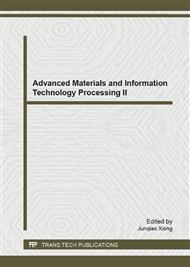[1]
J. Gehl, T.H. Sorensen, K. Nielsen, P. Raskmark, S.L. Nielsen, T. Skovsgaard, and L.M. Mir, In vivo electroporation of skeletal muscle: threshold, efficacy and relation to electric field distribution, Biochimica et Biophysica Acta, 1428 (1999).
DOI: 10.1016/s0304-4165(99)00094-x
Google Scholar
[2]
R. Heller, M. Jaroszeski, A. Atkin, D. Moradpour, R. Gilbert, J. Wands, and C. Nicolau, In vivo gene electroporation ang expression in rat liver, FEBS Letter, 389 (1996), 225-228.
DOI: 10.1016/0014-5793(96)00590-x
Google Scholar
[3]
G. A. Hofmann, S. B. Dev, S. Dimmer, and G. S. Nanda, Electroporation Therapy: A New Approach for the Treatment of Head and Neck Cancer, IEEE Transactions on Bio-Medical Engineering. 46, 6(1999), 752-759.
DOI: 10.1109/10.764952
Google Scholar
[4]
4. Pouyan E. Boukany, Andrew Morss, Wei-ching Liao, Brian Henslee, HyunChul Jung, Xulang Zhang, Bo Yu, Xinmei Wang, Yun Wu, Lei Li, Keliang Gao, Xin Hu, Xi Zhao, O. Hemminger, Wu Lu, Gregory P. Lafyatis, and L. James Lee, Nano channel electroporation delivers preciseamounts of biomolecules into living cells. Nature nanotechnology, 6 (2011).
DOI: 10.1038/nnano.2011.164
Google Scholar
[5]
A. K. Banga, S. Bose, and T. K. Ghosh, Review article-Iontophoresis and electroporation: comparisons and contrasts. International Journal of Pharmaceutics. 179 (1999) 1-19.
DOI: 10.1016/s0378-5173(98)00360-3
Google Scholar
[6]
V. Vijayanathan, T. Thomas, and T. J. Thomas, DNA nanoparticles and development of DNA delivery vehicles for gene therapy. Biochemistry. 41, 48(2002), 14085-14094.
DOI: 10.1021/bi0203987
Google Scholar
[7]
V. Legrand, P. Leissner, A. Winter, M. Mehtali, and M. Lusky, Transductional targeting with recombinant adenovirus vectors. Current Gene Therapy. 2, 3(2002), 323-339.
DOI: 10.2174/1566523023347823
Google Scholar
[8]
M. Trucco, P.D. Robbins, A.W. Thomson, and N. Giannoukakis, Gene therapy strategies to prevent autoimmune disorders. Current Gene Therapy, 2, 3(2002), 341-354.
DOI: 10.2174/1566523023347760
Google Scholar
[9]
D. Luo and W. M. Saltzman, Enhancement of transfection by physical concentration of DNA at the cell surface, Nature Biotechnology. 18 (2000), 893-895.
DOI: 10.1038/78523
Google Scholar
[10]
Guan J and Lee L J, Generating highly ordered DNA nanostrand arrays, Proceedings of the National Academy of Sciences of the United States of America. 102, 51(2005), 18321-18325.
DOI: 10.1073/pnas.0506902102
Google Scholar
[11]
Guan J, Yu B, and Lee L J, Forming Highly Ordered Arrays of Functionalized Polymer Nanowires by Dewetting on Micropillars. Advanced Materials. 19, 9(2007), 1212-1217.
DOI: 10.1002/adma.200602466
Google Scholar
[12]
Guan J, Ferrell N, Yu B, Hansford D J, and Lee L J, Simultaneous fabrication of hybrid arrays of nanowires and micro/nanoparticles by dewetting on micropillars, Soft Matter. 3, 11(2007), 1369-1371.
DOI: 10.1039/b709910j
Google Scholar
[13]
C H Lin, J Guan, S W Chau, and L J Lee, Experimental and numerical analysis of DNA nanostrand array formation by molecular combing on microwell-patterned surface, Journal of Physics D: Applied Physics. 42, 2(2009), 1-8.
DOI: 10.1088/0022-3727/42/2/025303
Google Scholar
[14]
Guan J, Boukany PE, Hemminger O, Chiou NR, Zha W, Cavanaugh M, and Lee LJ, Large laterally ordered nanochannel arrays from DNA combing and imprinting, Advanced Materials. 22, 36(2010), 3997-4001.
DOI: 10.1002/adma.201000136
Google Scholar
[15]
P.T. Yue, J. J. Feng, C. Liu, and J. Shen, A diffuse-interface method for simulating two-phase flows of complex fluids. Journal of Fluid Mechanics. 515 (2004), 293-317.
DOI: 10.1017/s0022112004000370
Google Scholar
[16]
Henrik Bruus, Theoretical microfluidics, (2005).
Google Scholar


